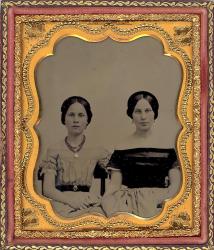
Ellen, William Pitt Preble, and Stephen Longfellow, Portland, ca. 1853
Maine Historical Society
Maine Historical Society (MHS) has collected photographs since the emergence of photography in the 1840s and maintains one of the largest and most significant collections of early Maine-related photographs in existence. MHS’ early photography collection offers extensive insight into the history of the state of Maine, as well as to the development of photography as a technology, discipline, art, occupation, cultural phenomenon, and language.
The Early Maine Photography collection at MHS is loosely categorized into two groups: The Vickery-Shettleworth Collection of Early Maine Photography and the MHS Early Photograph Compiled Collections. The former consists of James B. Vickery and Early G. Shettleworth, Jr.’s expansive collection of early photographs, initially donated to MHS in 2006. The late James B. Vickery amassed an impressive collection during his lifetime, a legacy Earle G. Shettleworth, Jr. continues to honor with yearly additions to the ever-growing collection.

Young woman in straw hat, ca. 1900
Maine Historical Society
The MHS Early Photograph Compiled Collections are an amalgamation of daguerreotypes, ambrotypes and tintypes which arrived at Maine Historical Society both independently or as part of larger acquisitions. Organized into collections based on medium, provenance, location and/or other criteria, the organizational structure of these collections documents the varied methods of collecting throughout MHS’ institutional history.
In respect to subject matter, there is overlap between the Vickery-Shettleworth collection and the MHS Compiled Collections, but for the purposes of this site, the two are treated as distinct. This presentation highlights James B. Vickery and Earle G. Shettleworth, Jr.’s dedication and commitment to Maine’s photographic history, while documenting the collecting legacy of the Maine Historical Society. Throughout this site, the two collection sub-groups are explored through a series of themed essays, aimed at showcasing the diverse history of 19th Century Maine through the photographic lens.
What makes a photograph "early"?

Unidentified women, ca. 1860
Maine Historical Society
In respect to photography, the widely accepted definition of early American photography ranges from the arrival of the technology to the United States in 1840 to Civil War (1861). MHS’ embraces a broader definition to include images from throughout the Civil War period and shortly after, placing the cut-off date at about 1870. As a result, MHS’ early photographic collections largely consist of three mediums: the daguerreotype, ambrotype and tintype (ferrotype). Also referred to as "cased images" (because of the elaborate enclosures used to house the more fragile formats), these three earliest mediums, starting with the daguerreotype, peaked in popularity between 1840 and 1870.
Technically, other 19th Century mediums, such as the cyanotype, albumen print, carte de visite, cabinet cards, or even lantern slides and glass negatives could be considered early, as many find their origins within the outlined time period. However, based on prevalence, accessibility and popularity, "early" is typically reserved for the daguerreotype, ambrotype and tintype.
This project was made possible in part by the Institute of Museum and Library Services MA-30-16-0356-16.